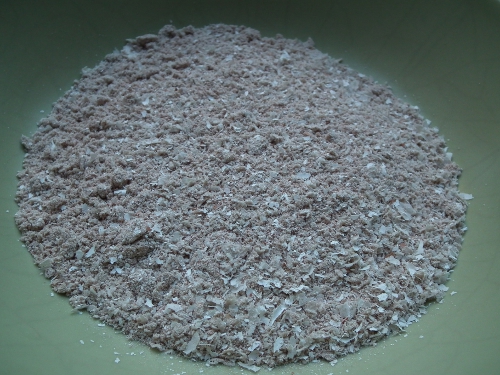We’ve not had a frost yet, but we will, this evening, and a hard one too: 28 F.  I have my thermometer out in the coop so we’ll know cold it will really get. I’ve harvested all there is to harvest, brought in all my potted plants, drained my rain barrels.  But, being a brand new chicken keeper, I am most concerned with the chickens, since their coop doesn’t have double walls or insulation (there is just particle board with siding).
In between drizzles I cleaned out the coop for the last time before Spring. I put down a sprinkling of diatomaceous earth to kill creepy crawlies like mites and fleas that may bother the birds. Then I shoveled in a thick layer of pine shavings, and on top of that I put straw, all adding up to about 5 inches.  This is the beginning of the deep litter method. I will simply add more shavings and straw as needed over the course of the Winter. The lower layers will decompose and give off heat, warming the coop. I also made sure that, apart from the ventilation which comes from the eaves, the little coop is draft free. I put extra bedding in the nest boxes – though I’m sure they’ll clean that out.  Our breeds – Rhode Island Red and Black Sex Link – are cold hardy, so they should be fine now.
We’ve been getting three eggs a day, and three days out of the week, four. So they’re good, consistent layers. The little pullet eggs have also been growing bigger, and yesterday we had a huge one.
Today I found a weird egg: the shell is all soft and crumpled and not entirely fused in places. The shape is squished. I hope this is a one-time problem!
To help with egg shell/calcium problems we’ve been giving them crushed oyster shell (in a separate feeder). In the meantime I was saving up the egg shells and yesterday I had enough to crush. I washed them, then made them brittle and cooked whatever egg was left in the microwave, then ran them through a coffee grinder we don’t use anymore. What a great way to close the loop!



Those odd, uncalcified eggs do happen occasionally. My friend tells me that her French cousins call them “vent oeuf” or ‘wind eggs.’ Not sure why. They’re fine to use, but do so quickly. That big egg will likely have two yolks – those are SO much fun!
My biggest challenge in winter is keeping them in liquid water. I have gone to five-gallon rubber horse waterers. When they freeze, I can just flip them over and whack them, and the ice falls out. They do get kind of messy if the birds soil in them (stoopid chickens!) but they’re easy to clean.
Also – I drop an immersible stock tank heater in my rain barrels, so I can capture the snow that melts off of the roof, and use that for my livestock. This is the one I have: http://www.amazon.com/gp/product/B000HHO3Z4/ref=pd_lpo_k2_dp_sr_3?pf_rd_p=486539851&pf_rd_s=lpo-top-stripe-1&pf_rd_t=201&pf_rd_i=B000I8VE68&pf_rd_m=ATVPDKIKX0DER&pf_rd_r=03MQA2B2CC2BDZVFFT3H
Good luck with the freeze tonight! I’m ready for it here in WMass, too.
Thank you, Michelle for the tip! We don’t have electricity in the tiny coop, so I’ll just have to break the ice once in a while. I usually go out and visit them four or five times as day anyway. I will look for that black bucket!